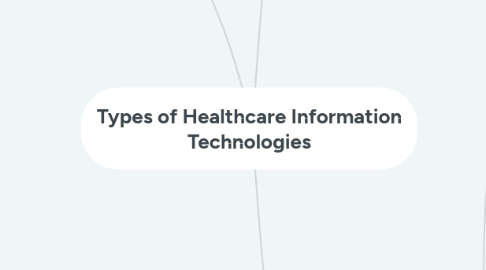
1. Communication
1.1. E-Prescribing
1.1.1. E-prescribing replaces the paperwork by allowing the doctors to communicate directly to the pharmacy through a database. Instead of showing up to pick up a prescription with the piece of paper the doctor wrote, the patients pharmacy can just pull up the information through the database.
1.2. Telehealth
1.2.1. The delivery of health-related services and information via telecommunications technologies. Telehealth could be as simple as two health professionals discussing a case over the telephone or as sophisticated as doing robotic surgery between facilities at different ends of the globe.
1.3. Secure Messaging
1.3.1. Secure messaging is the communication system that allows patients and providers to transmit personal and medical information through a streamlined database. It entails the same direction as email does, but it is under higher protection and privacy. This allows the provider and the patient more convenience to communicate on a regular basis.
1.4. Wireless Communication
1.4.1. Systems like Vocera Messaging offer platforms for users to send secure messages like lab tests and alerts to one another using smartphones, web-based consoles or third-party clinical systems. These messaging systems can expedite the communication process while still tracking and logging sent and received information in a secure manner.
1.5. Computerized Provider Order Entry
1.5.1. Computerized physician order entry (CPOE) is the process of a medical professional entering medication orders or other physician instructions electronically instead of on paper charts. A primary benefit of CPOE is that it can help reduce errors related to poor handwriting or transcription of medication orders.
1.6. Self-Service Kiosks
1.6.1. Similar to portal technology, self-service kiosks can help expedite processes like hospital registration
2. Patient Records
2.1. Computerized Disease Registries
2.1.1. Computerized disease registries are affordable and practical systems for physicians who seek to improve chronic care. Disease registries are system that tracks and manages disease-specific information for individual patients and populations. A registry is more affordable than an electronic medical record (EMR) system and is an effective tool for improving management of chronic conditions.
2.2. Electronic Dental Records
2.2.1. An electronic dental record is a dental chart that is available in an electronic database. The EDR is the same of an EHR, as it is meant to provide the oral health professional with the information necessary to chart electronically instead of using paperwork. .
2.3. Personal Health Records
2.3.1. Personal Health Records are "owned" by the individual patient instead of by the providers. This helps a patient keep track of information for the doctor to allow a better understanding of their overall health.
2.4. Electronic Health Records
2.4.1. EMRs allow more than one person to use a patient's chart, are usually better organized than paper records, eliminate illegible handwriting, and allow storage of more information.
3. Patient Care
3.1. Clinical Decision Support
3.1.1. Clinical decision support (CDS) provides clinicians, staff, patients or other individuals with knowledge and person-specific information, intelligently filtered or presented at appropriate times, to enhance health and health care. CDS encompasses a variety of tools to enhance decision-making in the clinical workflow. These tools include computerized alerts and reminders to care providers and patients; clinical guidelines; condition-specific order sets; focused patient data reports and summaries; documentation templates; diagnostic support, and contextually relevant reference information, among other tools.
3.2. Realtime Locating Services
3.2.1. Another growing data monitoring tool, real-time locating services, are helping hospitals focus on efficiency and instantly identify problem areas. Hospitals can implement tracking systems for instruments, devices and even clinical staff. These services gather data on areas and departments that previously were difficult to track. Tracking movement with a real-time locating service can highlight potential issues in efficiency and utilization. These tools also allow flexibility for last minute changes.
3.3. Remote Monitoring Tools
3.3.1. Remote patient monitoring (RPM) is a technology to enable monitoring of patients outside of conventional clinical settings (e.g. in the home), which may increase access to care and decrease healthcare delivery costs.
3.4. Sensors and Wearable Technology
3.4.1. Wearable medical devices and sensors are simply another way to collect data. Sensors and wearable technology could be as simple as an alert sent to a care provider when a patient falls down or a bandage that can detect skin pH levels to tell if a cut is getting infected
3.5. mHealth
3.5.1. Mobile health is freeing healthcare devices of wires and cords and enabling physicians and patients alike to check on healthcare processes on-the-go. Smartphones and tablets allow healthcare providers to more freely access and send information. Physicians and service providers can use mHealth tools for orders, documentation and simply to reach more information when with patients.
3.6. Portal Technology
3.6.1. Portal technology allows physicians and patients to access medical records and interact online.
